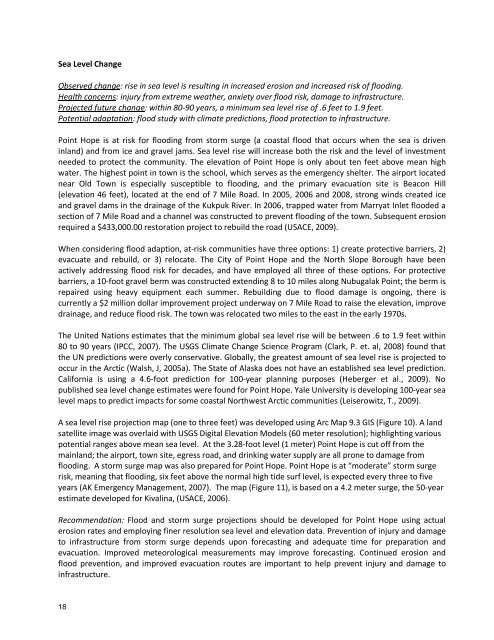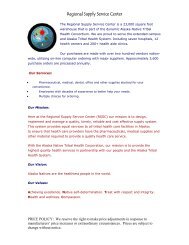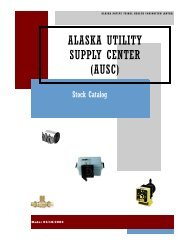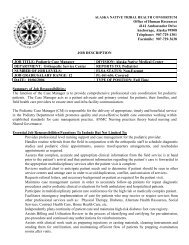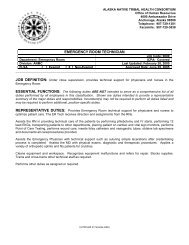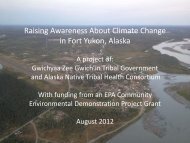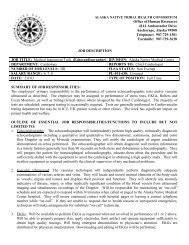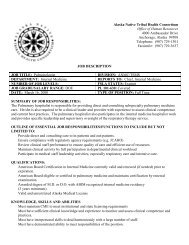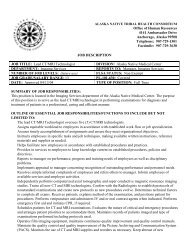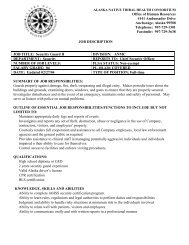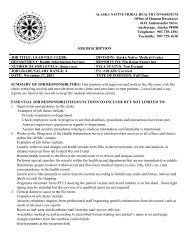Draft Final Climate Change and Health Impacts Point ... - ANTHC
Draft Final Climate Change and Health Impacts Point ... - ANTHC
Draft Final Climate Change and Health Impacts Point ... - ANTHC
You also want an ePaper? Increase the reach of your titles
YUMPU automatically turns print PDFs into web optimized ePapers that Google loves.
Sea Level <strong>Change</strong><br />
Observed change: rise in sea level is resulting in increased erosion <strong>and</strong> increased risk of flooding.<br />
<strong>Health</strong> concerns: injury from extreme weather, anxiety over flood risk, damage to infrastructure.<br />
Projected future change: within 80‐90 years, a minimum sea level rise of .6 feet to 1.9 feet.<br />
Potential adaptation: flood study with climate predictions, flood protection to infrastructure.<br />
<strong>Point</strong> Hope is at risk for flooding from storm surge (a coastal flood that occurs when the sea is driven<br />
inl<strong>and</strong>) <strong>and</strong> from ice <strong>and</strong> gravel jams. Sea level rise will increase both the risk <strong>and</strong> the level of investment<br />
needed to protect the community. The elevation of <strong>Point</strong> Hope is only about ten feet above mean high<br />
water. The highest point in town is the school, which serves as the emergency shelter. The airport located<br />
near Old Town is especially susceptible to flooding, <strong>and</strong> the primary evacuation site is Beacon Hill<br />
(elevation 46 feet), located at the end of 7 Mile Road. In 2005, 2006 <strong>and</strong> 2008, strong winds created ice<br />
<strong>and</strong> gravel dams in the drainage of the Kukpuk River. In 2006, trapped water from Marryat Inlet flooded a<br />
section of 7 Mile Road <strong>and</strong> a channel was constructed to prevent flooding of the town. Subsequent erosion<br />
required a $433,000.00 restoration project to rebuild the road (USACE, 2009).<br />
When considering flood adaption, at‐risk communities have three options: 1) create protective barriers, 2)<br />
evacuate <strong>and</strong> rebuild, or 3) relocate. The City of <strong>Point</strong> Hope <strong>and</strong> the North Slope Borough have been<br />
actively addressing flood risk for decades, <strong>and</strong> have employed all three of these options. For protective<br />
barriers, a 10‐foot gravel berm was constructed extending 8 to 10 miles along Nubugalak <strong>Point</strong>; the berm is<br />
repaired using heavy equipment each summer. Rebuilding due to flood damage is ongoing, there is<br />
currently a $2 million dollar improvement project underway on 7 Mile Road to raise the elevation, improve<br />
drainage, <strong>and</strong> reduce flood risk. The town was relocated two miles to the east in the early 1970s.<br />
The United Nations estimates that the minimum global sea level rise will be between .6 to 1.9 feet within<br />
80 to 90 years (IPCC, 2007). The USGS <strong>Climate</strong> <strong>Change</strong> Science Program (Clark, P. et. al, 2008) found that<br />
the UN predictions were overly conservative. Globally, the greatest amount of sea level rise is projected to<br />
occur in the Arctic (Walsh, J, 2005a). The State of Alaska does not have an established sea level prediction.<br />
California is using a 4.6‐foot prediction for 100‐year planning purposes (Heberger et al., 2009). No<br />
published sea level change estimates were found for <strong>Point</strong> Hope. Yale University is developing 100‐year sea<br />
level maps to predict impacts for some coastal Northwest Arctic communities (Leiserowitz, T., 2009).<br />
A sea level rise projection map (one to three feet) was developed using Arc Map 9.3 GIS (Figure 10). A l<strong>and</strong><br />
satellite image was overlaid with USGS Digital Elevation Models (60 meter resolution); highlighting various<br />
potential ranges above mean sea level. At the 3.28‐foot level (1 meter) <strong>Point</strong> Hope is cut off from the<br />
mainl<strong>and</strong>; the airport, town site, egress road, <strong>and</strong> drinking water supply are all prone to damage from<br />
flooding. A storm surge map was also prepared for <strong>Point</strong> Hope. <strong>Point</strong> Hope is at “moderate” storm surge<br />
risk, meaning that flooding, six feet above the normal high tide surf level, is expected every three to five<br />
years (AK Emergency Management, 2007). The map (Figure 11), is based on a 4.2 meter surge, the 50‐year<br />
estimate developed for Kivalina, (USACE, 2006).<br />
Recommendation: Flood <strong>and</strong> storm surge projections should be developed for <strong>Point</strong> Hope using actual<br />
erosion rates <strong>and</strong> employing finer resolution sea level <strong>and</strong> elevation data. Prevention of injury <strong>and</strong> damage<br />
to infrastructure from storm surge depends upon forecasting <strong>and</strong> adequate time for preparation <strong>and</strong><br />
evacuation. Improved meteorological measurements may improve forecasting. Continued erosion <strong>and</strong><br />
flood prevention, <strong>and</strong> improved evacuation routes are important to help prevent injury <strong>and</strong> damage to<br />
infrastructure.<br />
18


